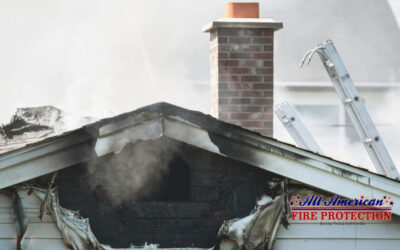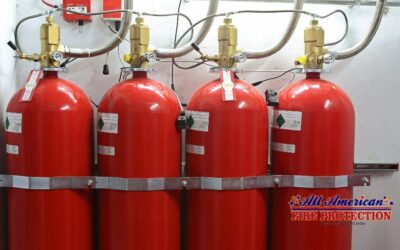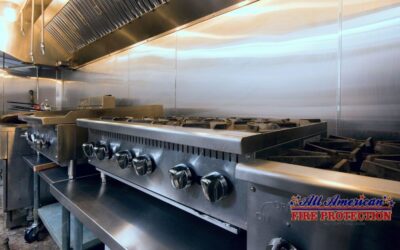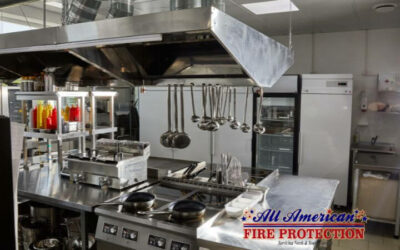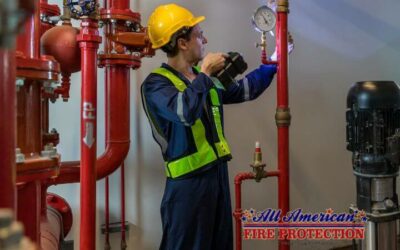Maintenance Checklist for Fire Suppression Systems
The security of your business, including your property, assets, and employees, is of utmost importance. Partnering with trusted providers like All American Fire Protection, specialists in fire suppression systems, ensures you’re adequately equipped for any eventualities. A key component of this security is a robust, reliable fire suppression system. But, it’s not just about having a system in place; regular maintenance is crucial to ensure its optimal performance when it’s needed most. This article provides a thorough checklist for maintaining your fire suppression system, covering everything from pre-maintenance preparations to post-maintenance procedures. By properly maintaining your fire suppression system, you not only protect your investment but also gain peace of mind knowing your business is prepared for any fire-related emergencies.
Understanding Fire Suppression Systems in a Business Context
Fire suppression systems are engineered to extinguish or control fires. They come in a variety of types, including water, foam, gas, and chemical-based systems, each tailored to suit the specific needs of a business. These systems are typically installed in high-risk areas such as kitchens, data centers, warehouses, and manufacturing facilities.
A fire suppression system comprises several key components: detection systems, control panels, alarm systems, suppression delivery networks, and the suppression agent. The detection system uses either ionization or photoelectric technology to sense abnormal heat or smoke levels and sends a signal to the control panel. Upon receiving this signal, the control panel activates the alarm system, alerting individuals on the premises. Concurrently, the suppression delivery network, which consists of a series of tubes or pipes, releases the suppression agent to control or extinguish the fire.
Understanding the interplay of these components is essential as it aids in identifying any malfunctions or anomalies during routine maintenance. Additionally, being aware of the type of suppression agent your system uses—whether water, foam, gas, or chemical—facilitates appropriate maintenance and informs you of potential safety implications in the event of an unintentional discharge.
Importance and Frequency of Regular Maintenance
The efficacy of a fire suppression system is critical in protecting both human lives and physical assets, with regular upkeep being the cornerstone of this effectiveness. Systems that are routinely serviced offer an extra layer of protection, mitigating the risk of preventable system malfunctions due to technical glitches, depletion of suppression agents, or obstructed delivery pathways.
Regular maintenance not only extends the lifespan of these components but also ensures their optimal performance during a fire emergency. A well-maintained system ensures a swift response, preventing minor incidents from spiraling into disastrous events. Neglecting maintenance can result in defective systems that fail to detect or suppress fires, leading to property damage or, in the worst-case scenario, loss of life.
The maintenance schedule is influenced by several factors, including the system type, its size, and the environment in which it operates. As a general guideline and in accordance with safety standards, fire suppression systems should be thoroughly inspected at least twice a year. However, it’s crucial to note that certain elements of these systems may necessitate more frequent attention. Always adhere to the manufacturer’s instructions and local fire safety regulations when maintaining your fire suppression system.
Pre-Maintenance Preparations
Prior to embarking on the maintenance of your fire suppression system, there are a few preparatory measures to consider. These steps not only ensure the safety of the person conducting the maintenance but also enhance the efficiency of the process.
Start by familiarizing yourself with your system’s maintenance manual. This resource, provided by the system’s manufacturer, outlines detailed procedures for conducting the maintenance check, including which components to inspect and the corresponding safety protocols.
Next, make sure you’re equipped with the necessary personal protective equipment (PPE). This is particularly crucial when handling suppression agents that could pose risks if improperly managed.
Additionally, it’s important to inform anyone on the premises about the upcoming maintenance check to prevent any unnecessary alarm caused by the triggering of system alerts during tests.
Finally, be prepared to record any observations and findings, either through prepared checklists or electronic devices. This information is invaluable for identifying trends in component failure, planning future maintenance schedules, and assessing the need for system upgrades.
Steps in Performing Fire Suppression System Maintenance
Embarking on the journey of fire suppression system maintenance involves a meticulous sequence of actions, each targeting a distinct element of the system. The importance of these steps cannot be overstated as they are the backbone of the system’s overall performance and reliability. The maintenance process ranges from simple tasks such as visual inspections and control panel assessments to more intricate procedures like examining detection systems and verifying the suppression agent. Each task demands precision and adherence to the guidelines outlined in the system’s maintenance manual to circumvent potential hazards.
Visual Inspection and Control Panel Check
Initiating the maintenance process begins with a comprehensive visual inspection. This step involves scrutinizing the system for any visible signs of wear and tear, such as physical damage, corrosion, or blockages in components like hoses, nozzles, and pipelines. Special attention should be given to parts that are exposed to harsh environmental conditions, as they are more susceptible to deterioration.
It’s also crucial to ensure that the system’s layout aligns with the manufacturer’s specifications. Any alterations, such as relocating components, could significantly impair the system’s efficiency.
Following the visual inspection is the control panel assessment. Regarded as the nerve center of the fire suppression system, the control panel must be in prime working condition. Look for any system error codes, warning lights, or other indications of malfunction. Verify that the settings are correct and that there are no signs of electronic faults. A compromised control panel could result in a system-wide failure, emphasizing the need for meticulous examination.
It’s essential to document any issues discovered during these inspections for future reference and remediation. The thoroughness and attention to detail during this phase lay the groundwork for the rest of the maintenance process.
Inspection of Detection and Alarm Systems
The heart of any fire suppression system lies in its detection and alarm mechanisms. It’s these components that act as the first line of defense, alerting occupants and triggering the suppression process. Thus, their regular inspection is a non-negotiable aspect of maintenance.
Begin with a thorough examination of the installation and positioning of various detection devices such as smoke detectors, heat sensors, and manual pull stations. These devices should be unobstructed and placed according to the manufacturer’s instructions. A clean detector is a functional detector, so ensure they are free from dust and grime to prevent false alarms or detection failures.
Next, put these detectors to the test. Use safe, approved methods to trigger each device and confirm its operation. For example, smoke cans can simulate smoke for testing smoke detectors, while harmless heat sources can be used for heat sensors.
Don’t forget the alarm systems. Check their audibility across all areas of the building and verify the operation of visual alarms like flashing lights.
Document your findings meticulously. Note any irregularities and determine whether they can be resolved immediately or require professional intervention. This step is crucial as a malfunctioning detection or alarm system can compromise the safety of the building’s occupants in a fire event.
Suppression Agent and System Components Check
The final, yet equally important, part of fire suppression system maintenance involves inspecting the suppression agent and key system components.
The suppression agent, whether it’s water, foam, dry chemical, or clean agent gas, is the system’s firefighting core. The agent used is typically determined by the specific fire risks present in your facility. For example, data centers often use clean agent systems that won’t damage electronic equipment.
Inspect the agent’s storage cylinders for full-pressure agent, any signs of damage, leaks, or discharge issues. Check the measurement gauges to ensure they’re displaying accurate levels. A compromised storage system can significantly hinder the system’s firefighting capabilities.
Next, evaluate other vital components like control heads, nozzles, piping, and hoses. Look for any signs of damage, leaks, corrosion, or blockages. Ensure the control head triggers correctly, the nozzles are unobstructed, and the pipes and hoses are leak-free and intact.
Conclude this phase of inspection by verifying that the automatic suppression means, whether it’s a clean agent, dry chemical, or sprinkler, is primed and ready to discharge when needed.
As always, document your findings comprehensively. This information will guide any necessary corrective actions and serve as a valuable reference for future inspections. Regular maintenance of these components is key to ensuring your suppression system is always prepared for a fire emergency.
Post-Maintenance Procedures
Once the meticulous process of fire suppression system maintenance is complete, it’s time to shift focus to the post-maintenance procedures. These are the steps that wrap up the maintenance session and ensure the system is primed and ready for action. This phase is not merely about tying up loose ends; it’s about ensuring the system’s readiness and addressing any issues that surfaced during the maintenance check. The importance of these procedures cannot be overstated, as they bolster the system’s reliability and guarantee that any hiccups encountered have been rectified for smooth operation.
Documenting Findings and Addressing Identified Issues
The completion of the maintenance check marks the beginning of an equally crucial task – documenting the findings. Every observation, no matter how insignificant it may seem, needs to be recorded. This includes any irregularities or issues that were spotted during the inspection. Keeping a detailed record of these findings aids in tracking progress and helps prioritize necessary repairs or replacements, thereby preventing the recurrence of the same issues.
When documenting, it’s important to note the date of the check, the specific parts of the system that were inspected, any abnormalities detected, and the corrective measures taken. This record serves a dual purpose – it acts as a guide for future maintenance checks and provides solid proof to insurance companies or regulatory bodies that the system is being well-maintained.
Addressing the issues identified during the check is a task that requires immediate attention. The severity of the problem will dictate the course of action. Minor issues may be resolved on the spot during the check, while more serious or complex problems will necessitate the expertise of professional fire system service technicians. It’s crucial to remember that postponing repairs can compromise your business’s safety by impairing the effectiveness of the fire suppression system.
By diligently documenting findings and promptly addressing identified issues, you can ensure the fire suppression system continues to operate at its peak efficiency.
Regular System Testing
Once maintenance has been completed, the next crucial step is to perform regular system testing. This process is vital to ensure the fire suppression system’s efficiency and effectiveness.
Testing of the fire suppression system should be a part of your standard operating procedures. It should be carried out based on the manufacturer’s recommendations or as mandated by the relevant regulatory bodies. The testing process typically involves activating the system and observing its response to ensure all components are operating correctly. It’s crucial to employ safe testing methods to prevent unnecessary system discharges or potential damage.
The scope of regular testing can vary. It may include specific component tests such as checking the alarm’s functionality, testing detectors, and conducting manual release tests. However, it should also encompass a comprehensive functionality test that evaluates the system’s response from the moment of detection to the act of suppression.
Maintaining detailed records of these tests is a must. These records should include the date of the test, the specific test carried out, the results, and any irregularities noted or actions taken. These records are not only vital for future maintenance checks but also for demonstrating regulatory compliance and ensuring the fire suppression system’s readiness.
In conclusion, the regular testing of your fire suppression system is a key factor in maintaining a safe and secure business environment. It provides the assurance that, in the event of a fire, your system will perform as expected, providing protection and peace of mind.


